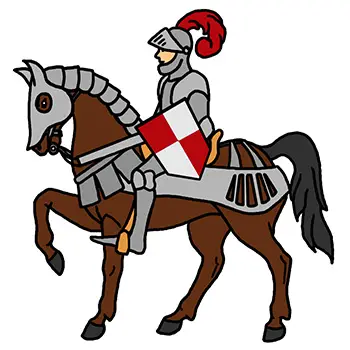Medieval War Horses
Horses in the Middle Ages were not grouped by breed. Instead they were grouped according to what the horse was used for. There were horses for battle, for travel, for speed and for working on the farm. Medieval war horses have become extinct although there have been efforts to breed horses of a similar size as medieval horses. A knight (if he could afford it) would often have a number of horses.
There are four different types of horses that would be used by an army during time of war.


The Destrier
The Destrier was the most expensive horse and were typically owned only by nobles and knights. Destriers were tall horses and were typically only used in battle. A destrier needed to be agile, fast, and strong. It needed to carry a lot of weight because the horse not only needed to carry a fully armored knight and his weapons, but also needed to carry armor of its own. Destriers were called “great horses” but there is not a lot of information about how big they actually were. The average size of a medieval horse was around 120 to 140 centimeters tall so it is probable that they were taller than this. By looking at horse armor from the Middle Ages, scholars have estimated that a destrier was around 150 to 160 centimeters tall.
A knight’s war horse could not be so tall that he needed help to get on the horse. If, during the course of battle, the knight was knocked off his horse, he needed to be able to jump back on the horse even though the knight was wearing full armor.
Destriers were specifically trained for battle or for use in tournaments. Since a knight riding into battle needed his hands free for fighting, the destrier would be trained to respond to pressure from the knight’s legs. Destriers were trained to not only bite and kick on command but to also trample fallen enemies.
Destriers were not common and as a result were highly sought after by knights (if they could afford them). Destriers were used in tournament jousts as well.

The Palfrey
The palfrey was used for riding, travelling, and hunting as well as for ceremonies. It could be used by knights in battle as well if necessary. A well-bred palfrey could cost just as much as a destrier.
The palfrey was not as big as a destrier. It was both shorter and longer. Riding a palfrey was much more comfortable and was the favourite riding animal of noble women.

The Courser
Coursers were fast horses and had good endurance. They were often used by messengers as well as by people who needed to move quickly. They were not as well trained as either the palfrey or destrier but they also cost a lot less.
Many knights who did not have access to a destrier preferred to ride a courser into battle because it was fast, strong, and agile.

The Rouncey
The rouncey could be used as a pack animal or even on the farm. It could be trained for war or used as a riding horse and was often used by knights who could not afford any of the other horses. A knight would also provide rounceys to his squires and other men at arms.

Horse Armor
Horse armor is called barding and the amount of armor on a horse really depended on the cost and whether the horse could handle the armor. The armour was made from boiled leather (cuir bouilli), padded cloth, or steel. Horse armor was actually more commonly worn during tournaments instead of in battle. Armor for a horse typically weighed around thirty-two kilograms.
There were different pieces of armor and each piece was designed to protect a different part of the horse.
Trappers: Trappers, which were also known as caparisons, were usually made from leather or cloth and was draped over the back of the horse. Trappers could reach the ground and even cover the whole horse from head to tail.
Peytral: The peytral coved the chest area of the horse and could go all the way back to the saddle.
Chamfron: This was one of the most important parts of a horse’s armor and was designed to protect the horse’s head. At times, it was decorated with horns or other designs was typically made from either leather or metal plates.
Flanchards: The flanchards were designed to protect the flanks of the horse. The flanchards were typically attached to both sides of the saddle and had openings on the sides so the knight could use his spurs.
Crupper: The crupper (also called the croupier) protected the rear of the horse.
Criniere: The criniere was typically made of segmented plates which were placed around the neck of the horse.
Horse armor was also often decorated and showed the colors of the knight that owned the horse.
War horses were an important part of the knight’s equipment. They were also important status symbols and every knight wanted to own the best horse they could afford.




